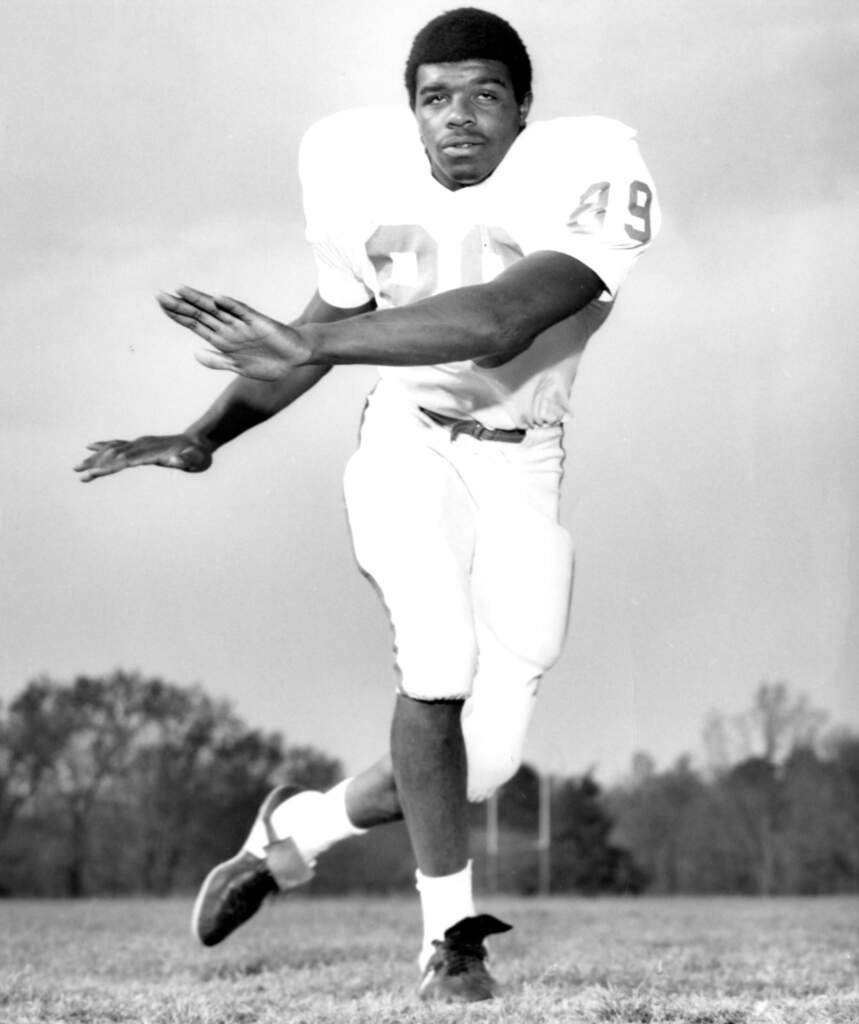Sept. 8, 2010
Editor’s Note: Clemson faces Presbyterian College on the gridiron this weekend. The same two teams met in Memorial Stadium on September 19, 1942, the first game in the history of the facility. We thought it was a good time to reflect on the history of Memorial Stadium. The following article was written by Clemson beat-writer Travis Sawchik of The Post & Courier (Charleston, SC).
The stadium rises from a peculiar place. Interrupting the rolling countryside and sunken in a valley, it rests 120 miles from the nearest major metropolitan area.
At any given moment, chances are someone, a student, visitor, or alumnus, is peering in the east gates of Memorial Stadium.
They gaze up at the symmetrical decks, which will fill again for today’s game against Presbyterian College. They peer down past Howard’s Rock to the field below.
Clemson’s cathedral is a spectacle – the 41st-largest stadium in the world and 21st-largest in the country. It seems a stadium so substantial must have been a priority.
However, its necessity was debated.
The stadium opened 68 years ago, isolated from the world, with the country in the midst of war, and the football program’s success hardly ensured.
Its creation changed forever the small military school and sleepy Southern town.
The Plan In the late hours of New Year’s Day of 1940, champagne toasts were likely in order at the Hotel Adolphus in Dallas, TX.
Hours earlier, Clemson capped the finest season in school history with a 6-3 Cotton Bowl win against heavily-favored Boston College. The day marked Clemson’s first bowl appearance and its eighth straight win, earning the Tigers a #12 AP ranking. It was their first such validation.
Among those traveling with the staff and 31 players were South Carolina Governor Burnet Maybank and Clemson University President Enoch Sikes.
Talk on the train during the day-long return on January 2 no doubt touched on events in Europe.
Germany invaded Poland in September, prompting war declarations from Britain and France. Would the country, would Clemson’s cadets be involved in another European war?
Clemson Coach Jess Neely added further soberness.
He informed the traveling party that Rice approached him in Dallas with a five-year contract offer at $10,000 per season.
Negotiations began on the train.
Officials offered to raise Neely’s salary from $6,000 up to $8,000, but to Neely, the issues extended beyond dollars.
Clemson was too isolated, too small.
Success was unsustainable.
By the end of January, Neely told Clemson officials he was leaving for Rice.
Sikes likely floated the idea of a new stadium on the train, which Neely thought foolish.
Neely advised his former assistant Frank Howard, elevated to head coach, to “never let them talk you into building a big stadium. Put about 10,000 seats behind the YMCA. That’s all you’ll ever need.”
Though some faculty members thought the stadium to be out-of-line with priorities, Clemson historian Jerry Reel said Sikes was influenced by the enthusiasm surrounding the 1939 season. When the traveling party slowed to a stop at the Clemson train depot, it was met by an estimated 400 people.
Sikes knew enrollment had doubled to 2,300 since he took office in 1925 at the all-white, all-male, land-grant school. He also knew the power of football as a marketing tool.
He conducted a study on how to improve the football program, which included the creation of a scholarship program (IPTAY) in 1934.
Sikes first proposed the stadium at a board meeting on March 22, 1940. Eight months later, the trustees authorized the plan. The stadium was financed with $110,000 in bonds.
But as the stadium project began, it was secondary news to Clemson students.
With the evacuation of Dunkirk and the subsequent French surrender in June of 1940, England stood alone against Germany.
The cadets followed the events through newspapers and huddled around crackling radios in the campus barracks. Edward R. Murrow’s broadcasts of the London Blitz were syndicated throughout the country.
“August 24, 1940. This is Trafalgar Square. The noise you hear at the moment is the sound of the air-raid sirens going off. …”
The Task The first business was to identify a site.
A steel structure was ruled out on two counts. Steel production declined during the Great Depression and steel was likely to become increasingly rare with war on the horizon.
In a March 22, 1940 letter to business manager J.C. Littlejohn, alumnus Dan Duncan advised a stadium of concrete “is the only kind that should be considered” and to further save cost, “it should be built in a ravine requiring no legs and minimum of form.”
Such a ravine existed on the western edge of campus, wooded and containing only cheap housing for campus workers.
To clear and survey the area were two sources of free labor…Howard’s football players and “Pop” Glenn’s engineering students. Glenn was charged with designing the stadium.
Following Clemson’s first Southern Conference title in 1940, construction began in the summer of 1941.
Charles Wright, 91, a junior in 1941, was among those conscripted.
“Coach Howard said we need some help and there we go,” said Wright, a 179-pound center from Decatur, GA. “It was not a paid job. We worked all summer, clearing brush, cutting trees, getting all the stuff off the field. We were excited. We hoped we would get to play in it if it was finished soon enough.”
As construction began in Clemson, Germany invaded the Soviet Union with an army of 4.5 million soldiers.
On November 26 as Clemson prepared for its 1941 season-finale at Auburn, a carrier task force left Japan for the central Pacific.
“In the back of our minds, we always knew we would have to go (to war) at one time or another,” said Wright, who sustained a shrapnel wound in Germany in 1945. “But that didn’t change our attitude about getting an education and doing the things we needed to do to get ready for it.
“We kept trying to do the best we could.”
Wright was in a campus barrack on December 7 when news broke of the attack on Pearl Harbor.
After West Point and Texas A&M, Clemson produced the most officers of any institution in World War II.
According to “Destined for Duty: The Clemson Class of 1941,” 6,000 Clemson cadets and graduates served in World War II and 373 were killed (4.3 percent of students and alumni), including 57 from the class of 1941.
The First Game The gates at the new stadium opened on September 19, 1942.
There was no running water or electricity, and the majority of the cadets had not yet enlisted because of age limitations.
Restrictions soon relaxed as the Nazi Empire stretched from France to southwestern Russia. In the Pacific, Marines battled the Japanese at Guadalcanal.
By 1943, nearly all of Clemson’s juniors and seniors were mobilized.
The graduating class numbered 13 in 1944.
For a moment, football offered a distraction.
The team dressed at Fike Fieldhouse, crossed Williamson Road, and descended down a hill at the open east end of the stadium to the field.
Minutes before kickoff today for their game against Presbyterian College, the Tigers will gather atop the same hill near Howard’s Rock, a stone from Death Valley, CA. It was given to Howard and placed atop the Hill on September 24, 1966.
“I remember coming into the stadium with the rest of the team,” Wright said of the first game. “It was really exciting to see people in the stands and all.”
The Tigers defeated Presbyterian College 32-13 that day.
Clemson football historian George Bennett said while Sikes and others began the construction process, it was Howard whose efforts persuaded the masses to come.
“It was built on faith,” Bennett said. “Howard got out and sold the program. He loved to go to meetings and he loved to talk in front of touchdown clubs. It wasn’t always the prettiest sight. He used some salty language. There weren’t any radio talk shows back then and there wasn’t all this other stuff we have now.”
After several routs at Clemson, Presbyterian College Coach Lonnie McMillian said in the late 1940s that he had “to take his team up to Clemson and play in Death Valley.”
The name stuck.
The stadium is also errantly referred to as Clemson Memorial Stadium against the wishes of the administration outlined in an April 15, 1942 letter from David Watson, chairman of the buildings and grounds committee, to President R.F. Poole:
“Clemson Memorial Stadium would imply that this stadium was built in honor of Mr. Clemson or some other person by the name of Clemson. A resolution unanimously adopted recommended the name Memorial Stadium. It was suggested that a bronze tablet be put up bearing this name and carrying an inscription to the effect that the stadium is dedicated to all Clemson men who have made the supreme sacrifice in the service of their country.”
The sacrifice ahead included two players who were on the train returning from the Cotton Bowl.
Aubrey Rion, a quarterback, was killed in Bastogne, Belgium on December 20, 1944 as part of the 101st Airborne. Joseph H. Richardson, the center on the 1940 team, piloted a B-26 bomber. He completed 38 missions before he was killed in a plane crash in February of 1944. Francis Zeigler, a three-time letterman in the 1920s, was also killed in combat.
To honor the Clemson men killed in combat, this past spring the alumni group Clemson Corps completed construction of the Scroll of Honor monument just to the east of the stadium.
Place to Worship If you study an empty Memorial Stadium, you will notice four shades of gray concrete, evidence of expansion at the stadium that started out with 20,000 seats.
Following the war, Clemson earned five top-20 rankings in 10 years and joined the Atlantic Coast Conference in 1953 as an original member.
As the student body grew, as demand grew, 18,000 seats were added above the initial bowl in 1958. An upper deck was added to the south side of the stadium in 1978, followed by a mirrored deck on the north side in 1983, pushing capacity to more than 80,000.
Of course, none of the expansion would occur and perhaps the program would never have joined the ACC if not for the lightest shade of gray, the initial pour, rising 46 rows above the playing surface.
“I think it was the beginning of a long line of activities that took place to bring it up to this standard,” Wright said. “But it was not something that happened overnight.”
In 1981, Neely, then a golf coach at Vanderbilt, told Bennett, “George, not in my wildest dreams did I ever think I would see a stadium like they have over there at Clemson. When I left, I told them don’t ever build anything over 20,000 seats.”
Near the same time, a visitor from England arrived at Clemson for research. She asked Reel, “Why spend such money on a stadium?”
“Pardon me?” Reel said. “I’ve been to St. Paul’s (Cathedral), it’s gorgeous, but when was the last time St. Paul’s was full? Oh, the wedding of Prince Charles…how many years ago was that? We fill our cathedral seven times a year.” His colleague’s response, “I guess you build where you worship.”
 Duke
Duke 
 Florida State
Florida State  Louisville
Louisville  Furman
Furman  South Carolina
South Carolina  LSU
LSU  Troy
Troy  Georgia Tech
Georgia Tech  Syracuse
Syracuse  North Carolina
North Carolina  Boston College
Boston College  SMU
SMU 






